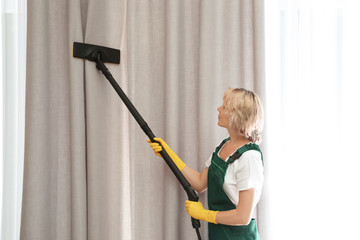Curtains are an essential element in home décor, adding both style and functionality to any room. Maintaining their pristine condition is crucial for prolonging their lifespan and ensuring they continue to enhance your living space. By following the proper cleaning techniques, you can keep your curtains looking fresh and new for years. In this comprehensive guide, we will delve into the best practices for curtain maintenance, offering detailed advice on everything from regular dusting to deep cleaning with Curtain Cleaning Sydney
Understanding Your Curtain Fabric
Identify Your Fabric Type
Different fabrics require different care. Cotton, linen, silk, polyester, and velvet are common curtain materials, each with unique characteristics and cleaning requirements.
- Cotton and Linen: These natural fibers are durable but can shrink if not handled properly.
- Silk: A delicate fabric that requires gentle handling and may need professional cleaning.
- Polyester: Easy to clean and generally machine washable.
- Velvet: Needs special care due to its pile and texture, often requiring dry cleaning.
Check the Care Label
Always start by checking the manufacturer’s care label on your curtains. This label provides essential information about the fabric and recommended cleaning methods. Ignoring these instructions can result in damage, shrinkage, or color fading.
Regular Maintenance for Curtains
Routine Dusting and Vacuuming
Regular dusting and vacuuming are crucial for preventing dirt build-up and extending the life of your curtains.
- Dusting: Use a feather duster or microfiber cloth to remove surface dust. Gently brush over the curtains, ensuring you reach the top where dust often accumulates.
- Vacuuming: Attach a soft brush to your vacuum cleaner and gently vacuum your curtains from top to bottom. This method is particularly effective for heavy fabrics like velvet or lined curtains.
Spot Cleaning
Accidental spills and stains are inevitable, but quick action can prevent permanent damage.
- Blot, Don’t Rub: Use a clean, white cloth to blot the stain. Rubbing can push the stain deeper into the fabric.
- Mild Detergent: For most fabrics, a solution of mild detergent and water can be used. Test this solution on a small, inconspicuous area first to ensure it does not cause discoloration.
Deep Cleaning Techniques
Machine Washing
Not all curtains are machine washable, but for those that are, follow these steps:
- Pre-Treatment: Pre-treat any noticeable stains with a stain remover.
- Cold Water Cycle: Use cold water to prevent shrinkage and color fading.
- Gentle Cycle: Select the gentle or delicate cycle to minimize wear and tear on the fabric.
- Mild Detergent: Use a mild, non-biological detergent suitable for delicate fabrics.
Hand Washing
Hand washing is often the safest method for delicate or non-machine washable fabrics.
- Fill a Tub: Fill a large basin or bathtub with lukewarm water and a small amount of mild detergent.
- Soak and Agitate: Submerge the curtains and gently agitate the water with your hands. Avoid scrubbing or wringing the fabric.
- Rinse Thoroughly: Rinse with clean water until all detergent is removed.
Dry Cleaning
For certain fabrics like silk and velvet, dry cleaning is the recommended method.
- Professional Service: Take your curtains to a reputable dry cleaner who has experience with delicate fabrics.
- At-Home Kits: There are at-home dry cleaning kits available, but use them with caution and follow the instructions carefully.
Drying and Ironing
Proper Drying Techniques
- Air Drying: Most curtains should be air-dried to prevent shrinkage. Hang them on a line or lay them flat on a clean surface.
- Avoid Direct Sunlight: Prolonged exposure to direct sunlight can cause fading. Dry your curtains in a shaded area.
Ironing and Steaming
- Low Heat: Use a low heat setting on your iron to smooth out wrinkles. For delicate fabrics, place a clean cloth between the iron and the curtain.
- Steaming: A fabric steamer can effectively remove wrinkles without direct contact. This method is particularly useful for heavy fabrics that are difficult to iron.
Special Considerations
Lined Curtains
Lined curtains require special attention as the lining material may have different care needs than the outer fabric. Always follow the most delicate care instructions applicable to either fabric.
Curtains with Embellishments
Curtains with embellishments such as beads, sequins, or embroidery should be handled with extra care. Hand washing or professional cleaning is often necessary to protect these details.
Sheer Curtains
Sheer curtains are delicate and can easily tear. Wash them in a mesh laundry bag on a gentle cycle, or hand wash them to prevent damage.
Seasonal Cleaning and Storage
Seasonal Cleaning
- Spring and Fall: Deep clean your curtains at least twice a year to remove accumulated dust and allergens.
- Rotate Curtains: Consider rotating your curtains seasonally to even out exposure to sunlight and wear.
Proper Storage
- Clean Before Storing: Ensure your curtains are clean and completely dry before storing them to prevent mold and mildew.
- Store in a Cool, Dry Place: Use breathable storage bags and store your curtains in a cool, dry place away from direct sunlight.
Conclusion
By following these detailed cleaning and maintenance techniques, you can significantly extend the life of your curtains, keeping them looking beautiful and fresh for years. Proper care not only enhances the aesthetic appeal of your home but also protects your investment in quality window treatments.





Comments